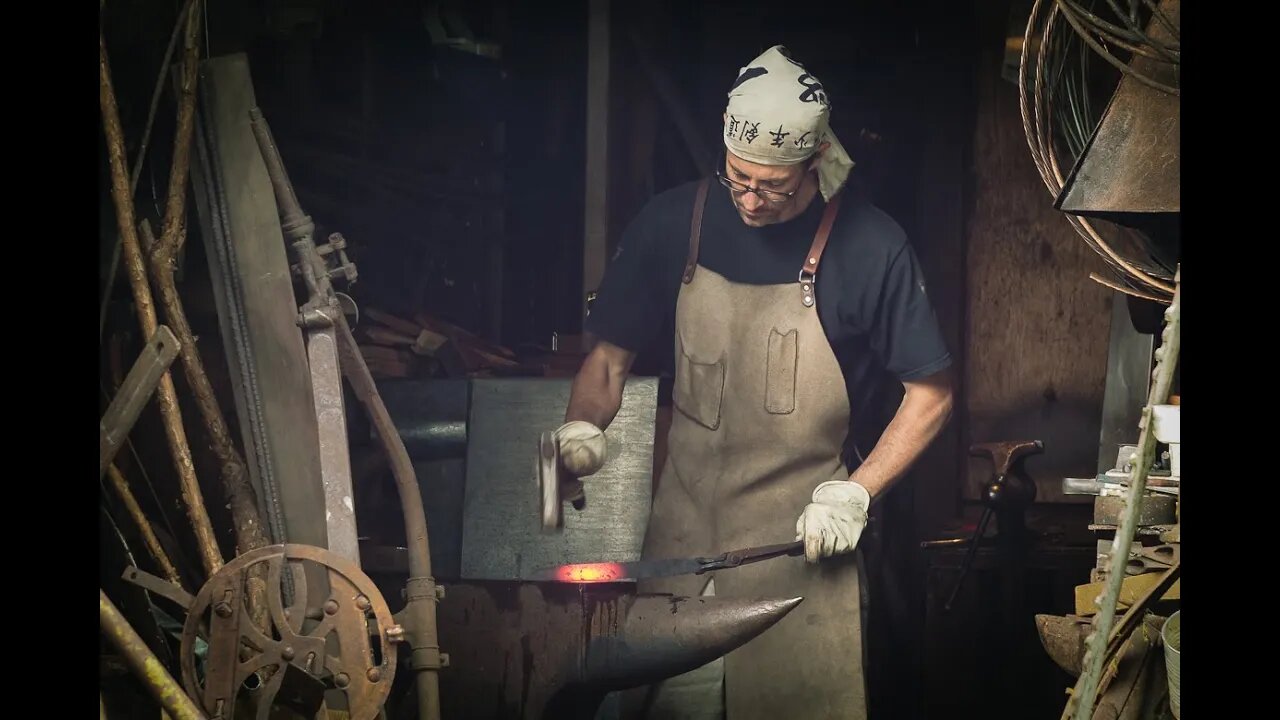Premium Only Content

TLDW #1 - Full Process: Forging a Shear Steel Tanto Blade - Historical Knife Making
***This is the full length version from start to finish (minus all the heating time), for the 4 minute radio edit, see: http://youtu.be/BcCrtq2c4vs
**Note that this is a classical Japanese style tanto based on the Aizu Shintogo: http://islandblacksmith.ca/2014/04/aizu-shintogo-kunimitsu-tanto-kata/
Charcoal forging a traditional tanto pattern blade from half of a reclaimed shear steel horse carriage leaf spring. The two distinct stages are sunobe and hizukuri...sunobe establishes the geometry and proportions, and hizukuri is putting in the bevels and creating the final shape. The final dimensions take a little extra care as this blade is being forged very closely to a traditional kata.
The kata I am measuring it against is the Aizu Shintogo, however there was not enough steel to produce the full thickness on the mune (motokasane) of the original blade. Info on the Aizu Shintogo tanto: http://islandblacksmith.ca/2014/04/aizu-shintogo-kunimitsu-tanto-kata/
More about classical tanto geometry: http://islandblacksmith.ca/tag/tanto-geometry/
The finished forging has a subtle recurve and a slightly dropping spine compared to the kata as the process of yaki-ire will cause the spine to curve upwards.
Shear steel is a very old and somewhat rare form of steel produced by increasing the carbon content of wrought iron using heat and charcoal to create a reduction atmosphere and then forge welding and folding layers together to homogenize the billet. Finished blade has distinct visible layers telling the story of its history.
Actual forging time including heating and some of the final work lost to battery issues was probably about 2 hours.
-
 1:59:29
1:59:29
Tim Pool
3 hours agoIsrael VS Palestine DEBATE, Misfit Patriot VS Rathbone | The Culture War with Tim Pool
94.6K139 -
 DVR
DVR
Simply Bitcoin
2 hours ago $0.79 earnedNEW DATA: FORGET The CRASH The Bitcoin Supply SHOCK is ACCELERATING | EP 1321
5.6K -
 4:22
4:22
Michael Heaver
2 hours agoLabour Make DISGUSTING Decision Against England
441 -
 1:05:42
1:05:42
Lara Logan
15 hours agoINSIDE THE MAR-A-LAGO RAID with Trump Attorney Christina Bobb | Episode 33
17.3K2 -
 1:38:45
1:38:45
Steven Crowder
4 hours agoAI Celebs Just Scammed Women out of Millions & Premium Interview w/ Patrick Christys
201K148 -
 43:48
43:48
The Mel K Show
3 hours agoMORNINGS WITH MEL K -This Labor Day Celebrate Liberty, Freedom & Family! 8-29-25
14.2K1 -
 59:02
59:02
The Shannon Joy Show
4 hours ago🔥🔥The Butchers At Hilo Benioff Hospital Hawaii - Mom Subjected To Forced C-Section & Abuse🔥🔥
20.1K2 -
 41:26
41:26
daniellesmithab
2 hours agoBetter, Faster, Smarter Access to Government Services
8.06K3 -
 LIVE
LIVE
LFA TV
7 hours agoLFA TV ALL DAY STREAM - FRIDAY 8/29/25
3,029 watching -
 44:41
44:41
Grant Stinchfield
20 hours ago $1.11 earnedEven DC’s Homeless Beg for Trump’s Law & Order — While Wacky White Liberal Women Scream NO!
16.1K3